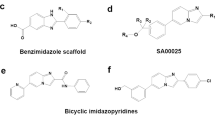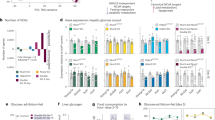Abstract
Nuclear orphan receptor Nur77 has important roles in many biological processes. However, a physiological ligand for Nur77 has not been identified. Here, we report that the octaketide cytosporone B (Csn-B) is a naturally occurring agonist for Nur77. Csn-B specifically binds to the ligand-binding domain of Nur77 and stimulates Nur77-dependent transactivational activity towards target genes including Nr4a1 (Nur77) itself, which contains multiple consensus response elements allowing positive autoregulation in a Csn-B–dependent manner. Csn-B also elevates blood glucose levels in fasting C57 mice, an effect that is accompanied by induction of multiple genes involved in gluconeogenesis. These biological effects were not observed in Nur77-null (Nr4a1−/−) mice, which indicates that Csn-B regulates gluconeogenesis through Nur77. Moreover, Csn-B induced apoptosis and retarded xenograft tumor growth by inducing Nur77 expression, translocating Nur77 to mitochondria to cause cytochrome c release. Thus, Csn-B may represent a promising therapeutic drug for cancers and hypoglycemia, and it may also be useful as a reagent to increase understanding of Nur77 biological function.
This is a preview of subscription content, access via your institution
Access options
Subscribe to this journal
Receive 12 print issues and online access
$259.00 per year
only $21.58 per issue
Buy this article
- Purchase on Springer Link
- Instant access to full article PDF
Prices may be subject to local taxes which are calculated during checkout







Similar content being viewed by others
Accession codes
References
Giguere, V. Orphan nuclear receptors: from gene to function. Endocr. Rev. 20, 689–725 (1999).
Winoto, A. & Littman, D.R. Nuclear hormone receptors in T lymphocytes. Cell 109 Suppl: S57–S66 (2002).
Nuclear Receptors Nomenclature Committee. A unified nomenclature system for the nuclear receptor superfamily. Cell 97, 161–163 (1999).
Germain, P., Staels, B., Dacquet, C., Spedding, M. & Laudet, V. Overview of nomenclature of nuclear receptors. Pharmacol. Rev. 58, 685–704 (2006).
Philips, A. et al. Novel dimeric Nur77 signaling mechanism in endocrine and lymphoid cells. Mol. Cell. Biol. 17, 5946–5951 (1997).
Wilson, T.E., Fahrner, T.J., Johnston, M. & Milbrandt, J. Identification of the DNA binding site for NGFI-B by genetic selection in yeast. Science 252, 1296–1300 (1991).
Liu, Z.G., Smith, S.W., McLaughlin, K.A., Schwartz, L.M. & Osborne, B.A. Apoptotic signals delivered through the T-cell receptor of a T-cell hybrid require the immediate-early gene nur77. Nature 367, 281–284 (1994).
Woronicz, J.D., Calnan, B., Ngo, V. & Winoto, A. Requirement for the orphan steroid receptor Nur77 in apoptosis of T-cell hybridomas. Nature 367, 277–281 (1994).
Cheng, L.E., Chan, F.K., Cado, D. & Winoto, A. Functional redundancy of the Nur77 and Nor-1 orphan steroid receptors in T-cell apoptosis. EMBO J. 16, 1865–1875 (1997).
Kagaya, S. et al. NR4A orphan nuclear receptor family in peripheral blood eosinophils from patients with atopic dermatitis and apoptotic eosinophils in vitro. Int. Arch. Allergy Immunol. 137 (suppl. 1): 35–44 (2005).
Li, H. et al. Cytochrome c release and apoptosis induced by mitochondrial targeting of nuclear orphan receptor TR3. Science 289, 1159–1164 (2000).
Wu, Q., Liu, S., Ye, X.F., Huang, Z.W. & Su, W.J. Dual roles of Nur77 in selective regulation of apoptosis and cell cycle by TPA and ATRA in gastric cancer cells. Carcinogenesis 23, 1583–1592 (2002).
Lin, X.F. et al. RXRalpha acts as a carrier for TR3 nuclear export in a 9-cis retinoic acid-dependent manner in gastric cancer cells. J. Cell Sci. 117, 5609–5621 (2004).
Pei, L. et al. NR4A orphan nuclear receptors are transcriptional regulators of hepatic glucose metabolism. Nat. Med. 12, 1048–1055 (2006).
Fu, Y., Luo, L., Luo, N., Zhu, X. & Garvey, W.T. NR4A orphan nuclear receptors modulate insulin action and the glucose transport system: potential role in insulin resistance. J. Biol. Chem. 282, 31525–31533 (2007).
Mangelsdorf, D.J. & Evans, R.M. The RXR heterodimers and orphan receptors. Cell 83, 841–850 (1995).
Baker, K.D. et al. The Drosophila orphan nuclear receptor DHR38 mediates an atypical ecdysteroid signaling pathway. Cell 113, 731–742 (2003).
Wang, Z. et al. Structure and function of Nurr1 identifies a class of ligand-independent nuclear receptors. Nature 423, 555–560 (2003).
Flaig, R., Greschik, H., Peluso-Iltis, C. & Moras, D. Structural basis for the cell-specific activities of the NGFI-B and the Nurr1 ligand-binding domain. J. Biol. Chem. 280, 19250–19258 (2005).
Chintharlapalli, S. et al. Activation of Nur77 by selected 1,1-Bis(3′-indolyl)-1-(p-substituted phenyl)methanes induces apoptosis through nuclear pathways. J. Biol. Chem. 280, 24903–24914 (2005).
Cho, S.D. et al. Nur77 agonists induce proapoptotic genes and responses in colon cancer cells through nuclear receptor-dependent and nuclear receptor-independent pathways. Cancer Res. 67, 674–683 (2007).
Brady, S.F., Wagenaar, M.M., Singh, M.P., Janso, J.E. & Clardy, J. The cytosporones, new octaketide antibiotics isolated from an endophytic fungus. Org. Lett. 2, 4043–4046 (2000).
Nolte, R.T. et al. Ligand binding and co-activator assembly of the peroxisome proliferator-activated receptor-gamma. Nature 395, 137–143 (1998).
Ray, D.W., Suen, C.S., Brass, A., Soden, J. & White, A. Structure/function of the human glucocorticoid receptor: tyrosine 735 is important for transactivation. Mol. Endocrinol. 13, 1855–1863 (1999).
Agostini, M. et al. Tyrosine agonists reverse the molecular defects associated with dominant-negative mutations in human peroxisome proliferator-activated receptor gamma. Endocrinology 145, 1527–1538 (2004).
Koehler, K.F., Helguero, L.A., Haldosen, L.A., Warner, M. & Gustafsson, J.A. Reflections on the discovery and significance of estrogen receptor beta. Endocr. Rev. 26, 465–478 (2005).
Chen, Z.P. et al. Pure and functionally homogeneous recombinant retinoid X receptor. J. Biol. Chem. 269, 25770–25776 (1994).
Cogan, U., Kopelman, M., Mokady, S. & Shinitzky, M. Binding affinities of retinol and related compounds to retinol binding proteins. Eur. J. Biochem. 65, 71–78 (1976).
Wu, Q. et al. Modulation of retinoic acid sensitivity in lung cancer cells through dynamic balance of orphan receptors nur77 and COUP-TF and their heterodimerization. EMBO J. 16, 1656–1669 (1997).
Cheskis, B.J., Karathanasis, S. & Lyttle, C.R. Estrogen receptor ligands modulate its interaction with DNA. J. Biol. Chem. 272, 11384–11391 (1997).
Pavan, L. et al. Human invasive trophoblasts transformed with simian virus 40 provide a new tool to study the role of PPARgamma in cell invasion process. Carcinogenesis 24, 1325–1336 (2003).
Najarian, T. et al. Preservation of neural function in the perinate by high PGE(2) levels acting via EP(2) receptors. J. Appl. Physiol. 89, 777–784 (2000).
Cain, S.A. et al. Fibrillin-1 interactions with heparin. Implications for microfibril and elastic fiber assembly. J. Biol. Chem. 280, 30526–30537 (2005).
Maira, M., Martens, C., Batsche, E., Gauthier, Y. & Drouin, J. Dimer-specific potentiation of NGFI-B (Nur77) transcriptional activity by the protein kinase A pathway and AF-1-dependent coactivator recruitment. Mol. Cell. Biol. 23, 763–776 (2003).
Wansa, K.D., Harris, J.M. & Muscat, G.E. The activation function-1 domain of Nur77/NR4A1 mediates trans-activation, cell specificity, and coactivator recruitment. J. Biol. Chem. 277, 33001–33011 (2002).
Chao, L.C. et al. Nur77 coordinately regulates expression of genes linked to glucose metabolism in skeletal muscle. Mol. Endocrinol. 21, 2152–2163 (2007).
Kolluri, S.K. et al. Mitogenic effect of orphan receptor TR3 and its regulation by MEKK1 in lung cancer cells. Mol. Cell. Biol. 23, 8651–8667 (2003).
Lin, B. et al. Conversion of Bcl-2 from protector to killer by interaction with nuclear orphan receptor Nur77/TR3. Cell 116, 527–540 (2004).
Wu, Q. et al. Inhibition of trans-retinoic acid-resistant human breast cancer cell growth by retinoid X receptor-selective retinoids. Mol. Cell. Biol. 17, 6598–6608 (1997).
Mullican, S.E. et al. Abrogation of nuclear receptors Nr4a3 and Nr4a1 leads to development of acute myeloid leukemia. Nat. Med. 13, 730–735 (2007).
Hassinen, T. & Peräkylä, M. New energy terms for reduced protein models implemented in an off-lattice force field. J. Comput. Chem. 22, 1229–1242 (2001).
Morris, G.M. et al. Automated docking using a Lamarckian genetic algorithm and an empirical binding free energy function. J. Comput. Chem. 19, 1639–1662 (1998).
Acknowledgements
We are grateful to S. Safe (Institute of Biosciences and Technology, Texas A&M University Health Science Center) for the vectors of GAL4-Nur77 and GAL4-LBD. We also thank F. Chen (Cancer Research Center, Xiamen University) for help with mouse experiments. This work was supported by grants from the National Natural Science Fund of China (30630070 and 30425014 to Q.W., 30325044 to Y.S.), grants from the “973” Project of the Ministry of Science and Technology (2006CB503905 to S.-C.L., 2004CB518800 and 2007CB914402 to Q.W.) and grants from the Ministry of Education (706036 to Q.W., 306010 to Y.S. and 705030 to S.-C.L.). Q.W., Y.S. and S.-C.L. are recipients of the National Science Fund for Distinguished Young Scholars. S.-C.L. is a Cheung Kong Scholar.
Author information
Authors and Affiliations
Contributions
Q.W., Y.S. and S.-C.L. designed experiments and wrote the manuscript. S.-C.L.'s group (Q.L., S.S., S.L., Z.Y. and D.H.) performed molecular experiments; Y.S.'s group (X.D., Q.X., Z.Z., Y.H. and W.S.) performed isolation, identification and preparation of Csn-B and Csn-C; B.C.W.'s group (D.C. and Z.C.) performed molecular modeling; Q.W.'s group (Y.Z., H.C., J.L., B.Z., L.Z., G.L. and M.Z.) performed the rest of the experiments.
Corresponding authors
Supplementary information
Supplementary Text and Figures
Supplementary Figures 1–6, Supplementary Tables 1–3 and Supplementary Methods (PDF 1760 kb)
Rights and permissions
About this article
Cite this article
Zhan, Y., Du, X., Chen, H. et al. Cytosporone B is an agonist for nuclear orphan receptor Nur77. Nat Chem Biol 4, 548–556 (2008). https://doi.org/10.1038/nchembio.106
Received:
Accepted:
Published:
Issue Date:
DOI: https://doi.org/10.1038/nchembio.106
This article is cited by
-
Nr4a1 promotes renal interstitial fibrosis by regulating the p38 MAPK phosphorylation
Molecular Medicine (2023)
-
An optimized Nurr1 agonist provides disease-modifying effects in Parkinson’s disease models
Nature Communications (2023)
-
NR4A1 Aggravates Myocardial Ischaemia–Reperfusion Injury by Inhibiting OPA1-Mediated Mitochondrial Fusion
Journal of Cardiovascular Translational Research (2023)
-
Natural compounds targeting nuclear receptors for effective cancer therapy
Cancer and Metastasis Reviews (2023)
-
HK1 from hepatic stellate cell–derived extracellular vesicles promotes progression of hepatocellular carcinoma
Nature Metabolism (2022)



